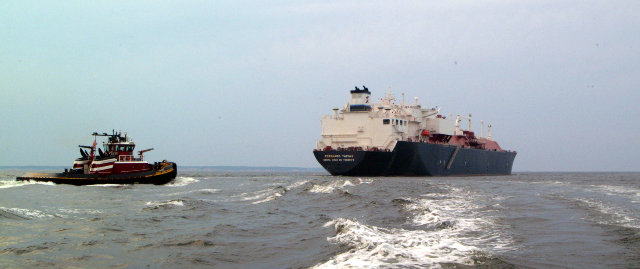The Chesapeake Bay is many things to many people. It is a playground, a fisheries resource, a magnet for development and a water highway for cargo, but it has never been part of the energy market to any significant extent. Unlike Texas and Louisiana, the region has not been exploited for natural resources aside from seafood. But all of that may change.
The Dominion Cove Point LNG terminal, located at a sleepy mid-bay location in rural southern Maryland, is on track to become the East Coast’s main export terminal for shale gas. The terminal has received conditional federal approvals from the Department of Energy, joining Lake Charles in Louisiana and Sabine Pass in Freeport, Texas. But like I said, Maryland is not accustomed to industrial energy complexes sharing the waterway. The Sierra Club made its most recent stand this week in the Court of Appeals seeking to overturn a lower court ruling that allows Cove Point to move forward in spite of the club's objections.
The Cove Point LNG terminal was opened in 1978 when the notion of hydraulic fracking wasn’t on anyone’s radar. The facility, built to receive imported gas, was quiet from the start and then completely inactive for decades. The ship pier, located a mile offshore, was known as a good spot for fishing and a relic of failed enterprise. Then, in the mid-2000s, Richmond, Va.-based Dominion Resources took over, expanded the plant and readied it to once again to receive LNG shipments. New tugs were built for towing the ships, and the pilots' association prepared for a new influx of service requests. Some quarters got all worked up about the potential for terrorist attacks on the ships. The party had barely started when the vagaries of the world commodity market intervened and the anticipated weekly ship calls were instead maybe once a month, sometimes less.
Then Marcelius Shale gas became available from Pennsylvania and West Virginia (Maryland has not jumped on that bandwagon yet) and Cove Point applied to begin exporting natural gas. The $3.8 billion construction project has been awarded to a joint venture of IHI E&C International Corp., a wholly owned subsidiary of IHI Corp., and Kiewit Energy Co. They will build a liquefaction plant from components shipped into the port of Baltimore and barged to the site, and then the party will start for the third time.
Not so fast, says the Sierra Club, whose 1972 settlement with original owners Columbia Gas included a clause allowing the group to veto future development. The agreement was updated in 2005 when the plant reactivated, and different interpretations of one sentence in that agreement could create a roadblock for Dominion or end the Sierra Club’s ability to stop the construction. At issue is whether this statement in the agreement, “ ... receipt by tanker and the receipt or delivery by pipeline” of natural gas in its various forms, means that the terminal can only receive LNG and deliver it domestically from the terminal or whether it means it can receive shipments via pipeline and deliver to the ship pier for loading. The lower court sided with Dominion. The opening arguments for the appeal were heard in Annapolis last week.
The Sierra Club and others are concerned that the plant’s liquefaction operations will generate large amounts of greenhouse gas. Neighbors worry about the impact on property values and an end to their quiet lifestyle. Others worry that Dominion will soon seek approval to tap the vast amount of shale gas believed to be trapped under the bay itself.
Stay tuned, the judge will rule on the appeal sometime this spring.




